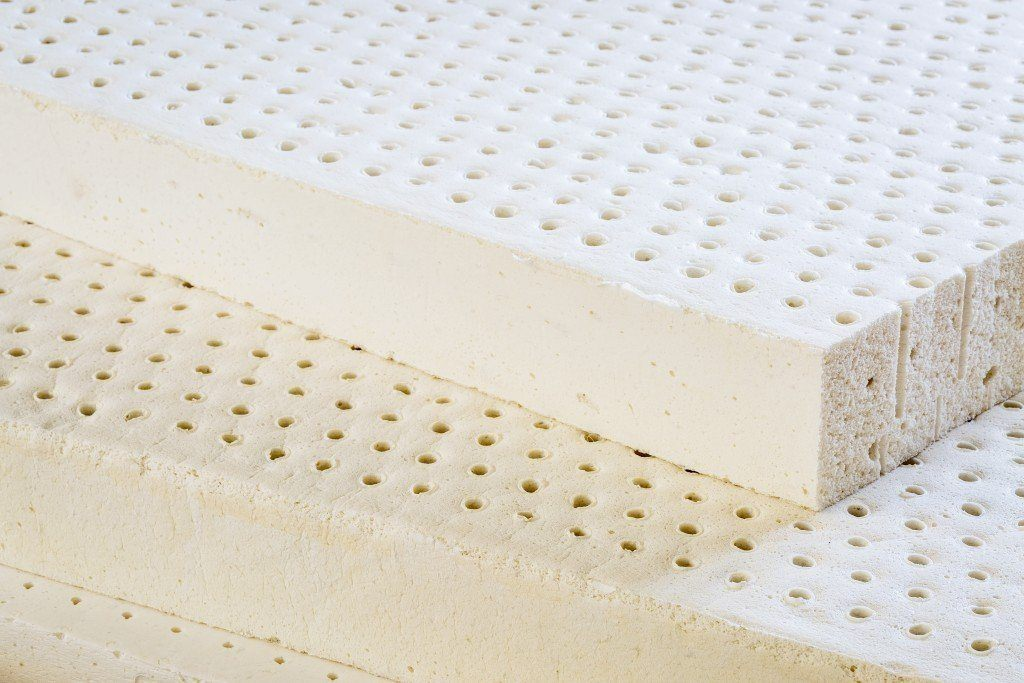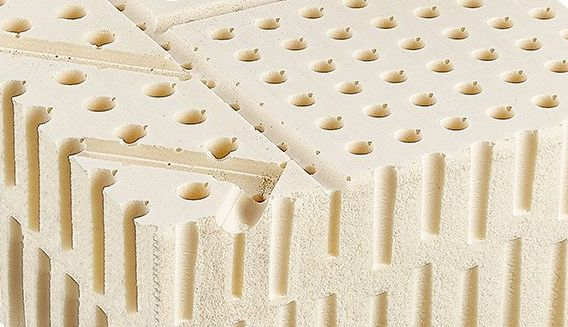Have you been eyeing that all-natural latex mattress you saw in the store? Or, maybe you’ve heard of all the benefits a latex mattress brings to your life compared to other mattress types?
A few minutes of your time learning about the pros and cons of a latex mattress will help you buy a best latex mattress that suits your sleeping habits. After all, you spend a third of your day in your bed, so a well-thought decision is needed.
This article will list all the advantages of a latex mattress, but before you continue reading have a think about these questions:
- Are you a hot sleeper?
- Are you a side sleeper?
- Do you have dust allergies?
If you answered ‘yes’ to any of them, then this article is for you. You’ll learn about the benefits of a latex mattress or why they may not suit you and what will.

Latex Mattress Overview
Latex is naturally made from the rubber sap of the Rubber Tree. And, different manufacturing processes of the natural material leads to varying firmness levels that, if chosen correctly, can help you get a better night’s sleep. There are 4 different types of latex:
- Dunlop latex is firmer, which makes it suitable for the spine alignment of people weighing more than 105 kg, back sleepers, and stomach sleepers.
- Talalay latex is softer, which makes it suitable for the spine alignment of people weighing less than 105 kg and side sleepers.
- Blended latex contains both natural and synthetic materials making it cheaper and more durable than natural latex-like Dunlop and Talalay.
- Synthetic latex is human-made by combining Styrene and Butadiene, which are petroleum derivatives, to create Styrene-Butadiene rubber (SBR). While much cheaper, the elasticity of latex is reduced and doesn’t give the same support as all-natural latex.
9 Benefits Of A Natural Latex Mattress
Among all the mattress types, latex is the only one made from all-natural materials, the liquid sap of rubber trees. Natural rubber latex foam:
- has elastic resilience
- insulates against sound
- absorbs shock
- has ventilation properties
There is also a synthetic version of latex which we’ll cover later. Here’s a rundown of the advantages of latex mattresses:
1. Mould Resistant
Organic latex is naturally antimicrobial which helps with mould resistance. But it also has a breathable structure where numerous air channels help promote air circulation through the mattress.
Since mould love a cold, humid, and moist environment, latex makes it harder for mould spores to grow. If you’re a hot sleeper that sweats a lot, then you’re better off with latex rather another type of mattress like memory foam as the increased ventilation helps dissipate the dampness.
But being mould-resistant has its limitations. Poor room ventilation, the weather and a mattress foundation that is not breathable enhances the risk of mould growth. That means no no-frame beds!
2. Good For People With Mobility Issues
A mattress made from all-natural latex is good for the elderly and people with mobility problems. Latex foam’s high resilience and responsiveness helps decrease that feeling of being ‘stuck’ in the bed as it does not contour as much to your body.
This much-needed benefit of natural latex also helps combo sleepers as they won’t have difficulties moving compared to a better contouring type.
3. Longer Lifespan Than Other Mattress Types
A latex mattress can last 12-20 years thanks to the natural rubber’s resiliency. You would think they’re popular for this alone, but the mattress industry has moved towards hybrids and memory foam mattresses which average around 7-year lifespans.
When pressure or weight is removed from a latex mattress, it bounces back easily to its original shape even after regular use.
This means that while it may be a bit more expensive, it’ll last nearly 3x as long as many mattresses – saving the money in your bank in the process.
On top of that, the high resilience property of latex foam ensures that even if there’s multiple users with different sleeping positions wear-and-tear shouldn’t show for over a decade.
4. Less Off-gassing (smell)
A latex bed does not smell like chemicals when it arrives, unlike other petroleum-based foam mattresses. Instead, it has a faint, sweet, almost vanilla-scented odour.
The initial odour of petroleum-based mattresses is called “off-gassing.” And, it’s caused by the chemicals and materials like synthetic foam, resin, adhesives, and flame retardants.
Some users report a faint ammonia smell caused by the small amount used in manufacturing. Still, it’s nothing to worry about as the foam is washed thoroughly in the manufacturing process.
5. Good For Back Sleepers
A latex mattress may be good for you if you’re a back sleeper or have back pain. Sleeping on a latex mattress feels like:
- Light
- Bouncy
- Responsive
- Just enough contouring
- Generalised compression
A study found that a latex foam mattress was better than a polyurethane mattress in pressure relief, as body contact pressures at the front, side, back torso, and side and back buttocks for side, front, and back sleeping positions. It will feel like sleeping on the mattress, not in it and this will ensure spine alignment during sleep so your back won’t hurt.
6. Cooling
Latex is a naturally cool substance, and keeps you cooler than a hot memory foam mattress. The open-cell structure of natural latex foam allows for continual ventilation and manufacturers improve its breathability by adding aerated channels.

Latex doesn’t typically conform close enough to your body to cut off ventilation. This lets body heat escape before it builds up and disrupts your sleep.
Tip: For extra coolness, make sure the mattress has a permeable cover, such as natural cotton or wool.
7. Eco-friendly
Rubber trees produce sap for up to 30 years, so trees are not constantly cut down for production. According to World Wildlife Fund, growing rubber trees is sustainable if done right. This is through growing trees on degraded land instead of clearing existing natural forests. Make sure to look for a latex mattress brand that uses this type of latex!
Natural latex is also biodegradable and can decompose from months to years, depending on the density of the material. Compared to polyurethane foam, which may take 1000 years to break down, natural latex is more eco-conscious.
8. Hypoallergenic and Low Maintenance
Microorganisms such as bacteria, fungi, and viruses can quickly build up on a mattress and produce mould, mildew, and dust mites if the bed is not cleaned regularly.
A hypoallergenic mattress can help with the problem if you have allergies. But how is a latex mattress hypoallergenic? Because of the dense structure of the latex foam, it prevents dust mites as it’s almost impossible to penetrate on the mattress.
Latex is regarded as naturally antimicrobial since it repels harmful microbes, making it a perfect alternative for people who suffer from allergies all year. You will benefit from latex mattresses if you suffer from sensitive skin, allergies, or skin problems like eczema.
Since dirt and dust are almost impossible to penetrate latex foams, it will give you a shorter time for cleaning. Cleaning a latex mattress is low maintenance because there’s no need for heavy vacuuming or cleaning. Regularly change of beddings will do for a week.
9. Motion Isolation
Have you experienced waking up in the middle of the night because your partner is tossing and turning in bed?
This is motion transfer that is usually experienced on an innerspring mattress. In latex mattresses, motion is more isolated than in pure spring mattresses. If you’re a couple and sharing the bed you won’t have to worry about being disturbed by their movements.
Cons Of Latex Mattresses
With all the benefits of latex mattresses we’ve shared, you’d think they must also be a downside. Well, there are a few.
Latex is also unsuitable for the 4.3% of the general population who are allergic to latex. Although they can still opt for a synthetic latex mattress, the benefits would differ from a natural latex mattress.
- Synthetic latex mattress are less durable than a natural latex mattress.
- They have off-gassing smells because of petroleum-based chemicals.
One way to check the authenticity of a natural latex mattress is to look for the Global Organic Latex Standard (GOLS) certification. This indicates that the mattress is made of organically grown natural rubber latex.
Not The Best Conformability
While latex foam may conform to your body, it may not be snug enough for some. If you’re searching for a mattress to help with chronic discomfort, a latex mattress may not be for you. If the mattress does not conform enough to your body, it may not be able to relieve all of the pressure and pain you require.
Consider looking at foam mattresses if your priority is maximum body conformity. Memory foam mattresses are known for this quality. If you’re unfamiliar with memory foam, read our what is a memory foam mattress guide.
Expensive
A latex mattress is on the high price spectrum of mattresses. With prices ranging from $500 to $2000, considering a 12-20 years lifespan is worth buying.
All-natural latex mattress costs range from £700, like this double-sized mattress from LatexSense, to £1,800, like this double-sized latex mattress from Demko.
Natural latex is already costly to manufacture due to the time for a rubber tree to mature and the transportation costs involved. On top of that, mattress brands use other natural materials like organic cotton and wool, further increasing the price.
Sleeping On A Latex Mattress Is Worth It
So far, we’ve laid out the pros and cons of latex and how it compared to other mattresses. If you’re considering a latex mattress, here’s a TL;DR of the above:
Advantages
- Mould-resistant
- Hypoallergenic
- Good pressure relief
- Good for the back
- Durable
- Responsive
- Little to no off-gassing
- Breathable
Disadvantages
- Higher price range
- Not suitable for people with latex allergy
- Not all latex mattress are synthetic
Do latex mattresses sleep hot?
Latex mattresses do not sleep hot compared to other conforming mattresses like memory foam. Primarily because of these factors:
– Low thermal conductivity of natural rubber
– Breathable structure of the latex mattress (air channels)
– Highly responsive foam that doesn’t make sleepers sink in the mattress
Does latex mattress need to breathe?
While its structure already includes air channels for ventilation, a latex mattress still needs to breathe.
Spindle, a latex manufacturer, recommends to use a slatted bed foundation made of real wood and spaced no more than three inches apart.
This will encourage maximum ventilation within the mattress and prevent any moisture build-up. Although latex mattresses are naturally mould resistant, a highly moist and poorly ventilated environment will promote mould growth.
Can bed bugs live in a latex mattress?
Yes, bed bugs can live in a latex mattress. Even though a latex mattress is dense and hypoallergenic, bed bugs are drawn to human life so their existence is not dependent on the mattress type itself. The same goes with a dust mite.
While you may be thinking twice about the price range of a latex mattress, considering its lifespan and other benefits, a latex mattress is still a good buy. You can always check the mattress certification to see if you’re getting an authentic natural latex mattress.
Overall, we can say that the advantages of a latex mattress outweighs its disadvantages.
Overall, we can say that the advantages of a latex mattress outweighs its disadvantages.
6 Sources
- Nanxi Zhang, H. C. (2020, March). Enhancement of the Antibacterial Activity of Natural Rubber Latex Foam by Blending It with Chitin. Retrieved from National Center for Biotechnology Information:
https://www.ncbi.nlm.nih.gov/pmc/articles/PMC7084390/ - McCay, S., & Mahlberg, P. (1973, February). Study of Antibacterial Activity and Bacteriology of Latex from Asclepias syriaca L . Retrieved from National Center for Biotechnology Information:
https://www.ncbi.nlm.nih.gov/pmc/articles/PMC444395/ - Mei, E. L., & Singh, M. (2010, December). The Dunlop Process in Natural Rubber Latex Foam. Retrieved from Research Gate:
https://www.researchgate.net/publication/309857169_The_Dunlop_Process_in_Natural_Rubber_Latex_Foam - Low, F.-Z., Chua, M. C.-H., Lim, P.-Y., & Yeow, C.-H. (2017, March). Effects of Mattress Material on Body Pressure Profiles in Different Sleeping Postures. Retrieved from National Center for Biotechnology Information:
https://www.ncbi.nlm.nih.gov/pmc/articles/PMC5310954/ - Padakan, R., & Radagan, S. (2016, May). Evaluation of benzenesulfonyl hydrazide concentration on mechanical properties, swelling and thermal conductivity of thermal insulation from natural rubber. Retrieved from Science Direct:
https://www.sciencedirect.com/science/article/pii/S2452316X16300333 - Wu, M., McIntosh, J., & Liu, a. J. (2016, March). Current prevalence rate of latex allergy: Why it remains a problem?. Retrieved from National Center for Biotechnology Information:
https://www.ncbi.nlm.nih.gov/pmc/articles/PMC5356959/






